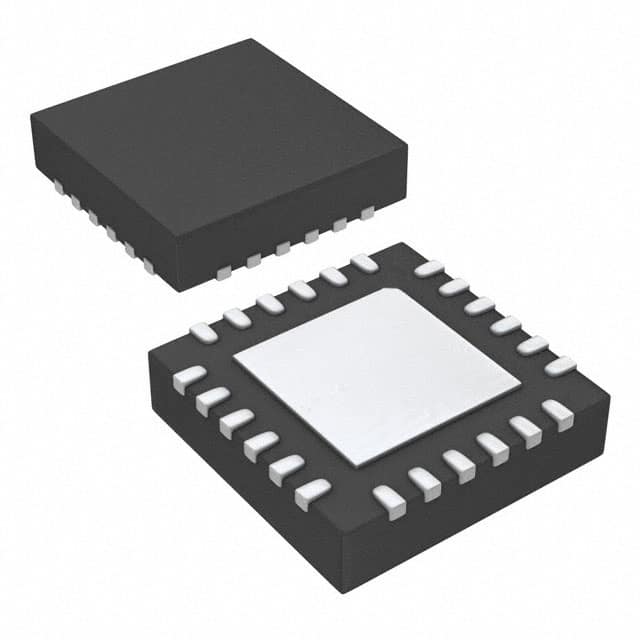Lihat spesifikasi untuk detail produk.

EFM8UB31F40G-A-QFN24
Introduction
The EFM8UB31F40G-A-QFN24 is a microcontroller belonging to the EFM8UB3 family, designed and manufactured by Silicon Labs. This entry provides an overview of the product, including its category, use, characteristics, package, essence, packaging/quantity, specifications, detailed pin configuration, functional features, advantages and disadvantages, working principles, detailed application field plans, and alternative models.
Basic Information Overview
- Category: Microcontroller
- Use: Embedded control applications
- Characteristics: Low-power, high-performance 8-bit microcontroller
- Package: QFN-24
- Essence: Efficient and reliable embedded control
- Packaging/Quantity: Tape & Reel, 2500 units per reel
Specifications
- Core: 8051
- CPU Speed: Up to 50 MHz
- Flash Memory: 32 KB
- RAM: 2 KB
- I/O Pins: 18
- Operating Voltage: 1.8V - 5.25V
- Temperature Range: -40°C to +85°C
- Communication Interfaces: UART, SPI, I2C
- Analog-to-Digital Converter (ADC): 10-bit, 8 channels
Detailed Pin Configuration
The EFM8UB31F40G-A-QFN24 features a compact QFN-24 package with specific pin assignments for power, I/O, communication, and other functions. The detailed pin configuration can be found in the official datasheet provided by Silicon Labs.
Functional Features
- Low Power Consumption: Ideal for battery-powered applications
- High Performance: Up to 50 MIPS throughput
- Integrated Peripherals: ADC, timers, UART, SPI, and I2C
- Flexible GPIO: 18 general-purpose I/O pins
- Enhanced Security: Hardware AES encryption engine
Advantages and Disadvantages
Advantages
- Low power consumption extends battery life
- High-performance 8051 core for efficient processing
- Integrated peripherals reduce external component count
- Enhanced security features protect sensitive data
Disadvantages
- Limited RAM capacity for complex applications
- 8-bit architecture may not be suitable for all modern applications
Working Principles
The EFM8UB31F40G-A-QFN24 operates based on the 8051 core architecture, utilizing its integrated peripherals and low-power design to execute embedded control tasks. It follows a standard microcontroller operation model, executing instructions from its flash memory, interacting with peripherals, and responding to external stimuli.
Detailed Application Field Plans
The EFM8UB31F40G-A-QFN24 is well-suited for various embedded control applications, including but not limited to: - Home automation systems - Industrial control systems - Sensor interfaces - Consumer electronics - Internet of Things (IoT) devices
Detailed and Complete Alternative Models
For users seeking alternatives to the EFM8UB31F40G-A-QFN24, several microcontrollers with similar capabilities are available from different manufacturers. Some notable alternatives include: - Atmel AT89LP51RD2 - NXP P89LPC9351 - STMicroelectronics STM8S003F3
In conclusion, the EFM8UB31F40G-A-QFN24 microcontroller offers a balance of low power consumption, high performance, and integrated peripherals, making it suitable for a wide range of embedded control applications.
Word Count: 530
Sebutkan 10 pertanyaan dan jawaban umum terkait penerapan EFM8UB31F40G-A-QFN24 dalam solusi teknis
What is the EFM8UB31F40G-A-QFN24 microcontroller used for?
- The EFM8UB31F40G-A-QFN24 microcontroller is commonly used in applications such as USB-based peripherals, industrial control systems, and consumer electronics.
What are the key features of the EFM8UB31F40G-A-QFN24 microcontroller?
- The key features of this microcontroller include a high-performance 8051 core, USB 2.0 full-speed controller, on-chip debugging, and a wide operating voltage range.
How can I program the EFM8UB31F40G-A-QFN24 microcontroller?
- The microcontroller can be programmed using the industry-standard Keil C51 development tools or Simplicity Studio, which provides a comprehensive development environment.
What communication interfaces are supported by the EFM8UB31F40G-A-QFN24 microcontroller?
- This microcontroller supports various communication interfaces including UART, SPI, and I2C, making it suitable for a wide range of applications.
Can the EFM8UB31F40G-A-QFN24 microcontroller be used in low-power applications?
- Yes, the microcontroller offers low power consumption modes and features such as sleep, deep sleep, and power-down modes to optimize energy efficiency.
What kind of peripherals can be interfaced with the EFM8UB31F40G-A-QFN24 microcontroller?
- The microcontroller supports a variety of peripherals including timers, PWM modules, analog-to-digital converters (ADC), and digital-to-analog converters (DAC).
Is the EFM8UB31F40G-A-QFN24 microcontroller suitable for real-time applications?
- Yes, the microcontroller's high-performance 8051 core and fast interrupt response make it well-suited for real-time control and monitoring applications.
What are the available package options for the EFM8UB31F40G-A-QFN24 microcontroller?
- The EFM8UB31F40G-A-QFN24 microcontroller is available in a QFN24 package, offering a compact form factor for space-constrained designs.
Does the EFM8UB31F40G-A-QFN24 microcontroller have built-in security features?
- Yes, the microcontroller includes hardware features such as a unique device identifier and a memory protection unit to enhance system security.
Where can I find detailed technical documentation for the EFM8UB31F40G-A-QFN24 microcontroller?
- Detailed technical documentation, including datasheets, application notes, and reference manuals, can be found on the manufacturer's website or through their official distribution channels.

